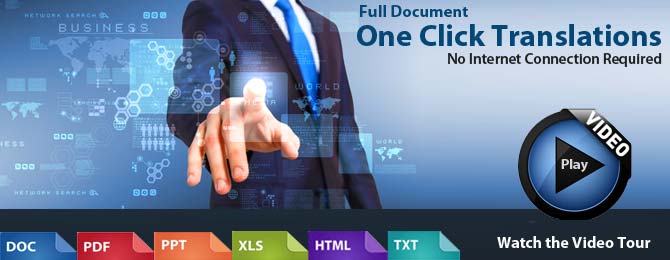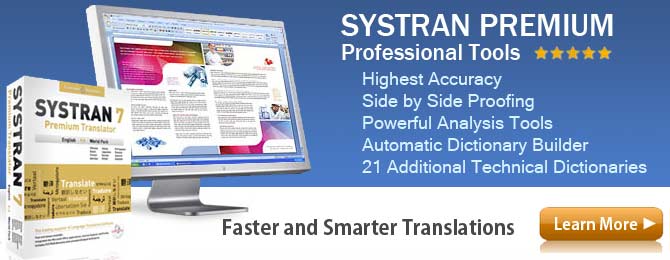What You Should Know About Free Translation Programs
The ability to speak more than one language can be an asset in both your personal life and in business. Many people speak more than one language and a select few can speak 10 languages or more. Even if you knew 25 foreign languages it is still only a small percentage of the thousands of languages in the world. With the internet many of us are suddenly connected to each other and the demand for translating foreign languages is higher than ever before. This is where translation software can be a very effective tool by helping to bridge the communication gap quickly. All software is not the same and there are many tools you should look for in a professional translating software in order to get good results.
History of Free Online Translators
Many of us have used the small translation box you see on Babel Fish but do you really know the story behind the box? It might surprise you to find out that translation software has been in development since 1957. It all started when Peter Toma, PhD., a linguist and researcher started working on the idea and later became involved in developing an English to Russian translation software (referred to as machine translation in the old days) for the U.S. Air Force.
In 1968, Dr. Toma established a company in California with a product called SYSTRAN, an acronym for System Translation. The company went on to be the leading developer in translation technology for many major corporations and Government agencies.
In 1997 a joint venture was formed between SYSTRAN and AltaVista and the result was BABELFISH, the world's first-ever online translation service. The best feature was the fact it offered translation for free. Something that had never been done before.
Systran is now the largest and most recognized translation software development company in the world ( learn more about the history of Systran).
Problems of Free Translation
You can achieve much higher translation accuracy with the software you purchase because you can control the translations. With the additional tools that are included you can set document styles, allow alternate meanings of a word to be displayed and override the default translations. Even if you do not speak the other language, the tools can increase the accuracy.
You will find with the more professional and expensive packages have a larger dictionary and also include advanced tools that give you both control and the ability to train the software. For example, the ability to create dictionaries with your own terminology, building translation memory dictionaries and performing additional analysis of the text before translation can greatly improve the results.
Many times I give the example of the word "mouse", it refers to a rodent, but if I am talking about computers the word means something completely different. Below is a sample of popular computer terms.
Example: Using an industry specific Dictionary for Computer Terminology would change the results.
| Word | General Dictionary Definition | Industry Terminology Dictionary Definition |
| mouse | a rodent | computer mouse |
| server | waiter in a restaurant | networked computer |
| windows | window in a home | operating system for computers |
You can also create your own dictionaries for special terminology or build a dictionary for certain dialects. Example, build a dictionary for Mexican Spanish terms.
The Biggest Challenge for Software is Avoiding Speech Ambiguity
Quick, pretend you are a translator and tell me what the following words mean.
Example, the word "train".
Answer: Train refers to a form of transportation, or was I referring to training someone.
You can see that even for a human translator it is often difficult to translate a word unless you can see the word used in a sentence properly. Software has this same challenge. Resolving "part-of-speech" ambiguity is one of the biggest challenges for translation software. One of the most common and difficult problems in English analysis is eliminating ambiguity between a noun and a verb. This problem is exacerbated because almost every short noun can be a verb.
Inserting articles helps eliminate ambiguity between a noun and a verb. Avoid abbreviated telegraphic style as much as possible by inserting "the" or "a" before a word with more than one part of speech.
Example:
Instead of: empty file / Use: empty the file (or) the empty file
Rule: Use articles to reduce part-of-speech ambiguity. Use 'the' and 'a', in front of the nouns.
Punctuation and Grammar is Very Important in a Rule Based Translation Engine, Observe the Rules
There are two types of translation technology currently on the market.
A) Rule-based: This uses the rules of the langauge to determine how the words should be translated.
B) Statistical : This uses pattern matching.
Rule-based technology has been the most accurate for almost 40 years but now SYSTRAN has a Hybrid Translation Engine that combines the best part of both technologies.
If you are working with a rule based automatic translation system it analyzes the structure of sentences in the source language (the language the user is translating from) and generates a translation based on the rules of the target language (the language the user is translating to). The process involves breaking down complex and varying sentence structures; identifying parts of speech; resolving the ambiguities; detecting punctuation; and synthesizing the information into the components and structure of the new language. This is a technical way of saying the software delivers more accurate translations if the input text uses good grammar rules.
Punctuation divides a sentence into logical parts. Without clear and correct punctuation, is it often possible to interpret a sentence in several ways.
| Sentence Structure and Using Main Clauses - Examples of Translated text with Software | |
| Input Text - English | Translation Software Output - French |
| Instead of: Supply Cassette The supply cassette has a spindle that includes notches for 14.5" widths. | Software Output: La Cassette débitrice la Cassette débitrice a un axe qui inclut des entailles pour des largeurs de 14.5". |
Use: Supply Cassette: The supply cassette has a spindle that includes notches for 14.5" widths. Or: Supply Cassette; The supply cassette has a spindle that includes notches for 14.5" widths. |
Software Output: La Cassette débitrice : La Cassette débitrice a un axe qui inclut des entailles pour des ll.argeurs de 14.5". |
| Rule: Place a comma before “and” or “but” to introduce an independent clause. You can also use a semicolon or start a new sentence. | |
Top 10 Tips for Getting Better Accuracy with Rule Based Translation Software
- Avoid slang and idioms.
- Spell check - checks for misspelled words.
- Use proper grammar and punctuation.
- Use short and declarative sentences.
- Create additional dictionaries with your own terminology.
- Use Industry Specific Terminology Dictionaries, i.e. computers, medical, engineering.
- Do Not Translate - Set up a list of words you do not want translated.
- Use articles with nouns, i.e. the car, a car, instead of just using car.
- Use sentence review tools - detects ambiguous words before translation i.e. the word ship can be a noun or verb.
- Translation Memory - build a database of pre-edited sentences.
Human Translators Replaced by Software?
Ok let's dispel this myth right now. Many human translators fear that software will replace them completely.
Actually we are getting closer due to newer technology and crowd sourcing. Currently software can deliver a very good "gisting" level of translation, but it still takes a human to understand the nuances of the language and to proof and edit the results.
The need for human translators is higher than it was 10 years ago because of the global reach of the internet. Translation software in the hands of someone who does not know the language they are translating from can be extremely helpful, but when a bilingual person uses translation software it becomes even more powerful. Many translating agencies and multilingual companies are using automatic translation software as a tool to reduce the time it takes to translate documents.
It only makes common sense to use software to produce a rough draft and then edit the results, much faster than translating from scratch on many types of documents. Translation software cannot deliver 100% accuracy so human translators will be needed for a very long time.
Summary
Determining whether you need a human translator or if you can consider a software solution really depends upon the document you are trying to translate and the level of accuracy required. Using translation software can definitely speed up the translating process and save companies thousands of dollars in cost but software is not intended to completely replace a human.
Translation software is considered a “gisting” application, producing translations that enhance the end-user’s understanding of the original document. It does not produce the same level of translation that a human translator could provide. The translated results are highly dependent upon the source text (original text) being well written with good punctuation and grammar. I have seen software deliver up to 90% accuracy on one document and only 70% on another, the difference was the original text. Also consider that with all software companies, one language may be more accuracte than another depending up on the developement the company has done.
Translation software can be used be the novice as well as the most advanced linguist. The wonderful thing about the latest versions of translation software is the additional tools that make the job easier for everyone.
The fact you recieve a letter or document in a foreign language and translate it with your computer in seconds is simply amazing. With new translation programs someone that cannot speak language can use software to translate webpages, chat, letters and other items to get a very good idea of the document's meaning.






